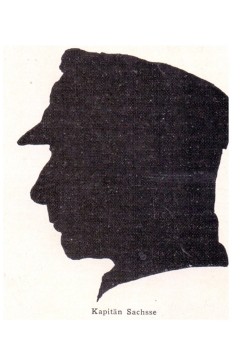
In 1914 German naval officers Lieutenant-Commander Fritz Sachsse and Lieutenant Herbert Straehler were both serving at the German colony of Kiautschou in north-eastern China. The colony was attacked and captured by a vastly superior Japanese force supported by a much smaller British contingent.
Straehler and Sachsse were both imprisoned in a prisoner-of-war camp in Fukuoka in Japan. In 1915 they managed to escape and find their way to mainland China. Their original intention had been to escape westwards, to make their way across the neutral countries of Asia, and return home to Germany via Persia and Turkey. They crossed the Great Wall of China and endured the punishing weather conditions in the Gobi Desert, but strong pressure from both Britain and Russia forced them to abandon this attempt. Instead they turned eastwards and proceeded back to the Pacific Coast where they separately worked their passages to America. The two Germans met up again in New York where they stowed away on a Norwegian passenger ship bound for Europe. The officers successfully crossed the Atlantic Ocean, but just after leaving Orkney, the ship was searched by crew members from a British naval vessel and the game was up! The officers identified themselves as German civilians and were interned on the Isle of Man.
The officers assumed different identities along their journey including upon arrival at Knockaloe. Straehler became Herbert Ungerer. He was interned on 25.11.1916 and said he was 29 years old. This information is contained on a record card held by the Red Cross in Geneva. Furthermore British lists of German prisoners of war, which also contained details of German civilian internees, also reveal that Ungerer’s next of kin was Felix A. Ungerer, that he lived at 5 Johannisstrasse in Ludwigsburg in Baden-Württemberg. He had been born in Berlin.
Sachsse assumed the identity of 41-year-old Hans Edeler. His next of kin was Frau Maria Edeler and his home address and place of birth were given as 55 Beselerallee in Kiel in Schleswig-Holstein. Both officers remained at Knockaloe until mid 1918 when they were transferred to Skipton Camp for officers in North Yorkshire.
Sachsse entered Skipton Camp for Officers in North Yorkshire on 18 June 1918. Straehler was admitted some weeks later on 8 August 1918. The British prisoner-of-war list commented dryly for each officer: ‘He has now furnished his correct name and particulars.’ The German story was that the officers had renounced their assumed identities when they learnt of possible officer exchanges being conducted via Holland.
The Spanish flu epidemic was to wreak havoc at Skipton Camp in February and March 1919. There were 47 fatalities from a total population of just 546 officers and 137 men. It is believed the mortality rate from the disease was one of the highest, if not the highest, of any camp in the UK.
Fritz Sachsse became the German Senior Officer at the camp in March 1919. His major task was to rebuild the shattered morale of his surviving comrades. He proved a popular and effective leader. His most enduring achievement was to co-edit a book the German officers at Skipton wrote about their experiences at Skipton. Largely written in the camp, it was smuggled out of the camp when the prisoners were released from captivity in October 1919. It was published in Germany the following year. At over 300 pages long Kriegsgefangen in Skipton is quite a remarkable book, containing illustrations, poems and first-hand accounts written by around 50 of the German officers. It also includes a very short account of Sachsse and Straehler’s own escapes.
Sachsse had left Germany in October 1913. He eventually returned home just over six years later in October 1919, having completely circumnavigated the world.
Fritz Sachsse and Herbert Straehler both returned to active service in a much depleted German Navy. Sachsse retired from service in the 1920s and seems to have specialised in short-term appointments, presumably as a temporary stop-gap or a troubleshooter. He retired with the rank of Rear Admiral.
Straehler served until 1943 and he too retired with the rank of Rear Admiral.
Researched and written by Alan Roberts, a World War One historian who is currently researching Skipton Camp.
Sources as noted, including a book published in 1984 by two American academics Burdick and Moessner, The German Prisoners-of-War in Japan, 1914-1920.
January 2018